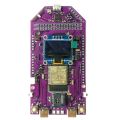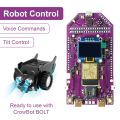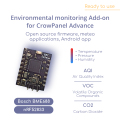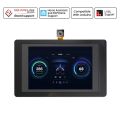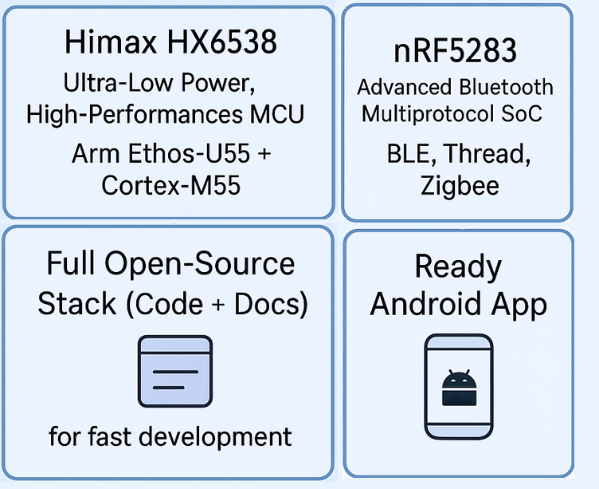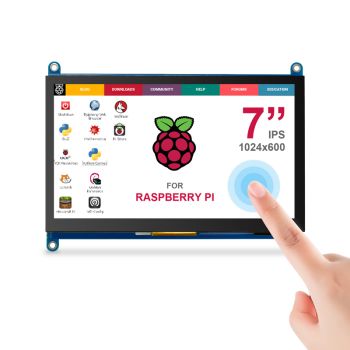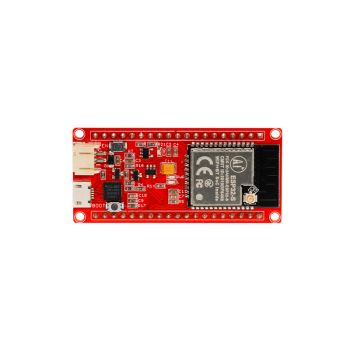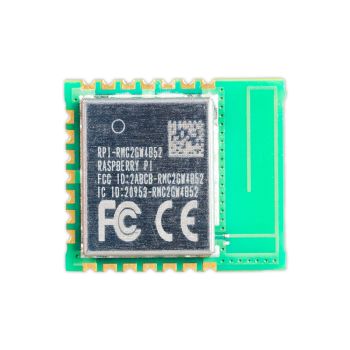Battery-Powered Edge AI Module on Himax HX6538 with Cortex-M55 & Ethos-U55 | Open-Source Platform
Battery-powered Edge AI module featuring Himax HX6538 and Nordic Bluetooth SoC — includes full open-source stack and Android app for fast development.
Who is it for?
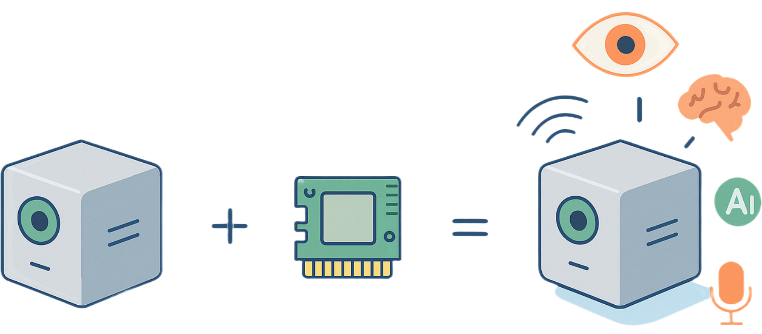
The GRC AI Module is designed for developers, hardware startups, and product teams who need a fast, reliable way to build battery-powered edge AI solutions. It's ideal for use in wildlife monitoring, license plate recognition, security systems, mobile robotics, and other smart sensing applications.
Ready-to-use Example Applications
Gate — Standalone ANPR Module for Gate & Barrier
A fully autonomous, battery-friendly module that opens your barrier or gate when it detects a recognized license plate.
Wild — autonomous long-term AI camera trap
Battery-powered AI camera trap for wildlife monitoring. Detects animal and bird species using onboard neural networks — no cloud or internet required.
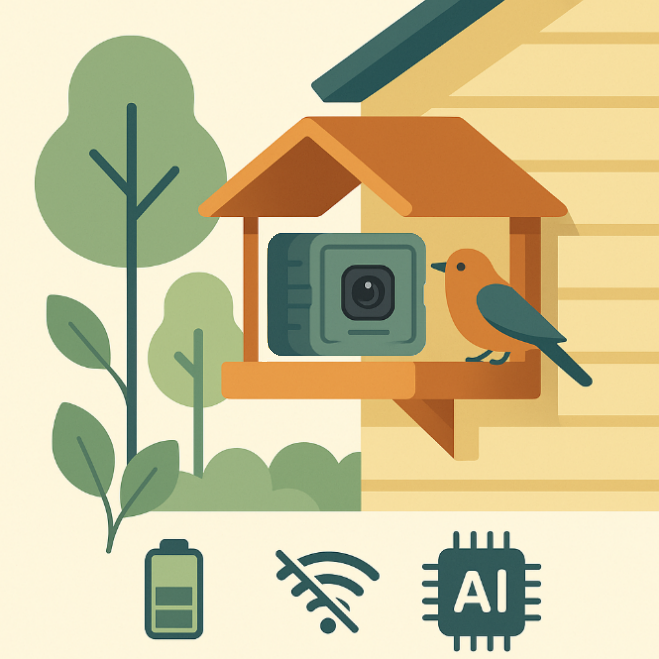
What can you do with it?
With this module, you can:
- Run neural networks for object detection and classification (e.g., animals, vehicles, license plates);
- Capture and process audio and video directly on the device;
- Develop fully autonomous systems that run on batteries or rechargeable power;
- Integrate it as a drop-in component into your final product — for example, a wildlife camera trap, smart garage door opener, or portable analyzer.
Key benefits
- Ready-to-use platform: Includes camera interface, microphone array, uSD storage, ToF sensor, IMU, and Bluetooth — all pre-integrated.
- Open-source stack: Full firmware, Android app, and documentation available to accelerate development and customization.
- Ultra-low power: Based on the Arm Cortex-M55 and Ethos-U55, ideal for battery-operated and always-on applications.
- Fast time to market: Use the module as a finished component — build your enclosure, add your model, and go to production.
Open-source projects for rapid product development
Examples:
- Wildlife camera trap — animal/bird species recognition;
- License plate recognition (LPR/ANPR);
- Smart garage door opener
- Custom object detection/classification systems.
An open-source object detection and classification project that you can customize for your specific use case
End-to-End Development Workflow

1. Platform Evaluation
- You have a pre-configured dev kit
(hardware + firmware + pre-trained model) - Run out-of-the-box demo (e.g., animal detection) to test:
- Inference performance (FPS, accuracy)
- API integration (REST/gRPC/edge SDK)
- Hardware compatibility (CPU/GPU/NPU utilization)
- Review the API specification and model compatibility guidelines via the pre-built demo
2. Custom Model Integration
Swap the default demo neural network for a task-specific model
(e.g., ANPR for local license plates) via:
- DIY path: adapt existing models;
- White-glove service: Grovety delivers a custom model (optimized for target hardware).
3. Prototype to Production
- Modify the open-source board firmware to implement custom business logic;
- Enhance the mobile app with required features and UI/UX changes;
- Finalize the hardware: uses existing enclosure or develops custom hardware.
Outcome: A ready-to-sell solution with low development costs and short time-to-market.
Subsystems & Their Functions
Under Himax control
- Image capture from camera module
- Audio acquisition from 4-microphone array
- Image processing using built-in hardware accelerators
- Image/audio processing using neural networks and Arm Ethos
- Data exchange with nRF52833 via SPI/I2C interfaces
- microSD card operations
Under nRF52833 control
- Himax communication via SPI and/or I2C interfaces
- Host communication via Bluetooth and/or USB-UART interfaces
- Power management and device configuration
- (Himax, accelerometer, ToF sensor)
- Battery charging control and state monitoring
- LED control and button state reading
Hardware Components List
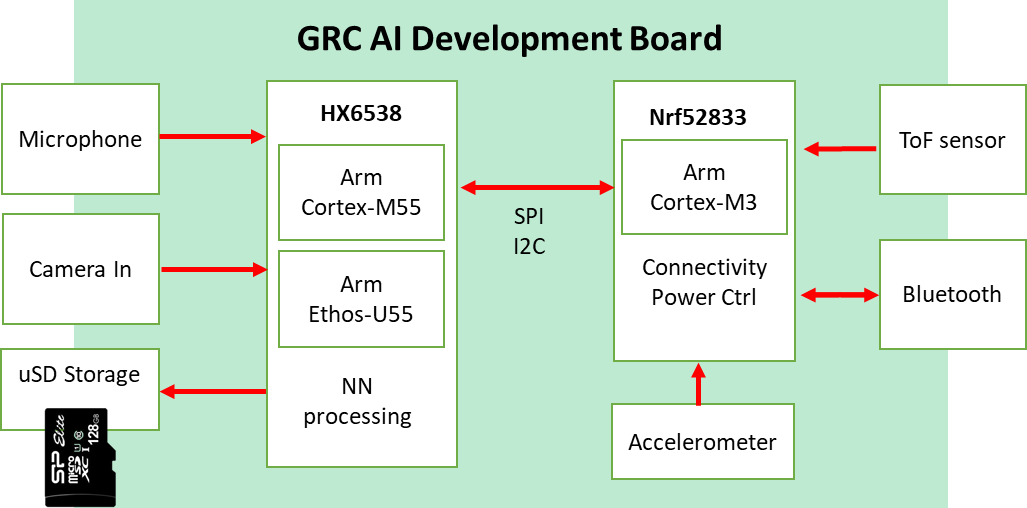
1. Processing Units
- Main MCU: HiMax HX6538 – Handles primary tasks:
- Neural network acceleration (Ethos-U55 NPU)
- Camera interfacing (MIPI CSI-2)
- Microphone array processing (PDM/PCM)
- uSD card storage management
- Peripheral MCU: Nordic nRF52833 – Manages:
- Bluetooth 5.2 Low Energy connectivity
- Power management (battery/DC-in)
- Time-of-Flight (ToF) sensor data acquisition
- Inertial Measurement Unit (IMU) processing
2. Sensors & Peripherals
- Imaging:
- Camera-In (MIPI interface) – Primary vision input
- Camera-Out (Debug/auxiliary feed)
- Audio:
- Dual PDM microphones – Beamforming-capable
- Environmental:
- ToF sensor (VL53L5CX or equivalent)
- 6-axis IMU (Accel + Gyro)
3. Storage
- uSD card slot – For high-capacity logging (video/audio)
- NOR Flash (64Mb+) – Firmware/ML model storage
Advanages
Fast start & Efficient Development with full open-source stack
- Camera integration pipelines
- Communication/transport infrastructure
- Out-of-the-box Android integration
Energy-Efficient Edge AI
- Ultra-low-power inference
- Scalable performance per watt
- Customizable for battery-powered deployments
Flexible Customization for Your Use Case
- Easily swap the neural network for your own model (e.g., ANPR, wildlife recognition)
- Modify firmware, APIs, and business logic as needed
- Customize Android app features and UI; adapt hardware enclosure if needed
Fast Track from Prototype to Product
- Complete open-source stack (code, docs, working examples)
- Short time-to-market and low development cost
- Optional Grovety support for optimized models and integration
Additional links:
Open-source object detection and classification project





